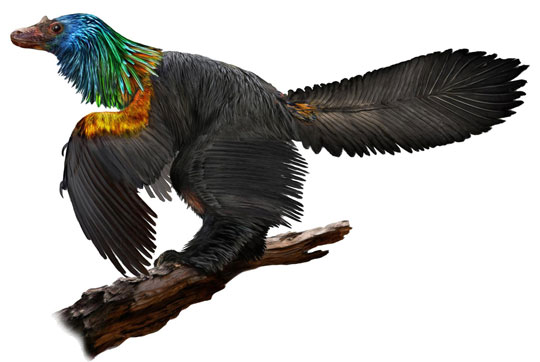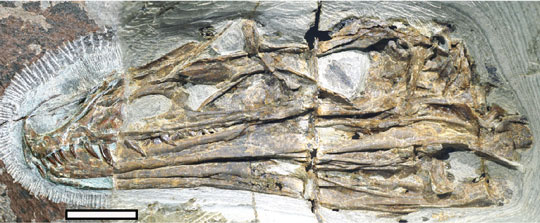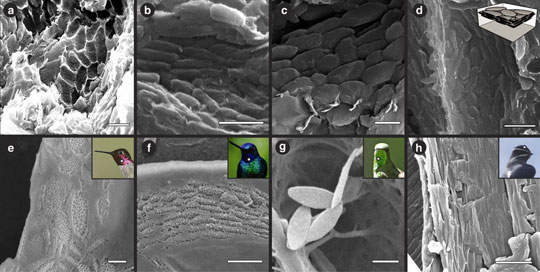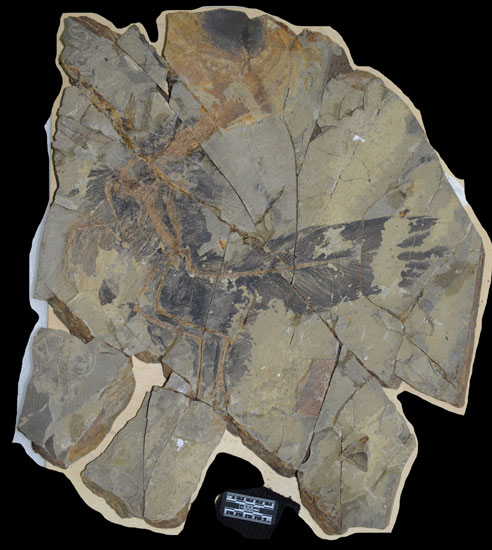Caihong juji – A Very Flashy Dinosaur
A team of scientists, writing in the journal “Nature Communications”, have described a new species of feathered dinosaur from Jurassic-aged rocks in China. The dinosaur has been named Caihong juji, which means “rainbow with the big crest” in Mandarin. This duck-sized dinosaur sported a bony crest on the top of its snout and its neck feathers may have been iridescent, as brightly coloured as feathers seen on humming birds today.
An Illustration of the Newly Described Feathered Dinosaur Caihong juji

Picture credit: Velizar Simeonovski
Caihong juji A Bird-like Dinosaur
Caihong has been assigned a basal position in the Deinonychosauria, a clade of theropod dinosaurs that includes the dromaeosaurids and the troodontids and it roamed the forests of northern China some 161 million years ago (Oxfordian faunal stage of the Jurassic). Although it was very bird-like, it was very different from its contemporary Anchiornis (A. huxleyi), as it lacked the bird-like triangular skull, however, it did possess proportionately long forearms. C. juji had a long, narrow skull, superficially similar to the skulls of the much later Velociraptorinae.
The Fossilised Skull of the Newly Described Basal Deinonychosaur Caihong juji

Picture credit: Hu et al
A Shaggy Ruff of Rainbow Feathers
Lead author of the study, Professor Dongyu Hu (Shenyang Normal University), in collaboration with scientists from the University of Ghent, the Chinese Academy of Sciences, the University of Texas at Austin and the University of Geosciences (Beijing), subjected the fossil specimen to scanning electron microscope analysis to characterise 2,460 structures associated with the feathers.
Cross-sectional focused ion beam imaging revealed the presence of melanosomes, which are responsible for pigmentation and colouration. When these fossil structures were compared to extant birds, the scientists were able to determine that Caihong had a shaggy ruff of iridescent, brightly-coloured feathers.
Platelet-like Nanostructures Indicate Iridescent Feathers (Caihong juji)

Picture credit: Nature Communications/Chao P.C.
The scanning electron microscope images above show platelet-like nanostructures on the fossilised feathers of C. juji (a-d). These structures are then compared with melanosomes found in living birds, (e) Anna’s humming bird (Calypte anna), (f) a white tailed starfrontlet (Coeligena phalerata), a black-tailed trainbearer (Lesbia victoriae) and a moustached treeswift (Hemiprocne mystacea), picture (h).
Commenting on the significance of the discovery, Professor Julia Clarke (University of Texas at Austin) stated:
“Iridescent colouration is well known to be linked to sexual selection and signalling and we report its earliest evidence in dinosaurs. The dinosaur may have a cute nickname in English, Rainbow, but it has serious scientific implications.”
A Combination of Ancient and More Modern Features
The fossil material, consisting of a slab and its counter slab was discovered by a farmer in 2014 at Gangou, Qinglong, (northern Hebei Province). The rocks in this area are associated with the Tiaojishan Formation and exposures are also found in the neighbouring province of Liaoning. Numerous feathered theropods have been found in the compressed volcanic ash layers and other sedimentary rocks associated with this region of northern China.
Caihong possessed a bony crest, a feature associated with earlier theropods from the Triassic and the Early Jurassic, the crest may have played a role in display or perhaps helping to distinguish males from females. The bony crest could have evolved as a result of sexual selection pressure. This ancient theropod feature contrasts with the identification of feathers with iridescence, this is the first time that such a feature has been identified in a non-avian dinosaur.
Caihong juji Fossil Material

Picture credit: Nature Communications
For dinosaur and prehistoric animal models: Prehistoric Animal and Dinosaur Figures.
Asymmetrical Feathers
Caihong is also the earliest known dinosaur to have had asymmetrical feathers, similar in shape and structure to those feathers found on the wings of modern birds that help to control flight. However, unlike extant birds, Caihong’s asymmetrical feathers were on its tail, not its short forelimbs, a discovery that suggests that early birds may have used their tails to help steer or to assist with lift.
Co-author of the research, Xing Xu (Chinese Academy of Sciences) explained:
“The tail feathers are asymmetrical but wing feathers are not, a bizarre feature previously unknown among dinosaurs including birds. This suggests that controlling [flight] might have first evolved with tail feathers during some kind of aerial locomotion.”
Professor Clarke added:
“This combination of traits is unusual. It has a rather Velociraptor-looking low and long skull with this fully feathered, shaggy kind of plumage and a big fan tail. It is really cool… or maybe creepy looking depending on your perspective.”
An examination of the tail feathers associated with the 40 centimetre-long Caihong specimen suggests that the tail feathers would have provided a larger surface area than the famous Archaeopteryx, a theropod capable of powered flight, that lived a few million years later. A spokesperson from Everything Dinosaur explained, that although Caihong could have been arboreal and it may have hopped from branch to branch, it was probably not volant (capable of powered flight).
Evidence of Mosaic Evolution
The combination of ancient and more modern anatomical traits in this basal deinonychosaur is an example of mosaic evolution, whereby, several different traits evolve independently. The team hope to continue their research in a bid to understand how Caihong juji fits into the story of the evolution of flight in the Dinosauria.
The scientific paper: “A Bony-crested Jurassic Dinosaur with Evidence of Iridescent Plumage Highlights Complexity in Early Paravian Evolution” by Dongyu Hu, Julia A. Clarke, Chad M. Eliason, Rui Qiu, Quanguo Li, Matthew D. Shawkey, Cuilin Zhao, Liliana D’Alba, Jinkai Jiang and Xing Xu published in the journal “Nature Communications.”
Everything Dinosaur acknowledges the assistance of a press release from the University of Texas at Austin in the compilation of this article.
Everything Dinosaur website: Everything Dinosaur.






Leave A Comment